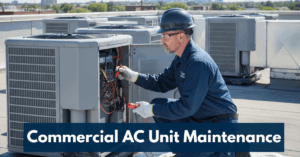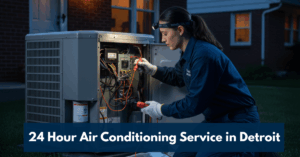As temperatures rise in Detroit, MI, finding a reliable and energy-efficient cooling solution becomes essential. Mini split AC units have quickly become one of the most popular options for homeowners seeking comfort without the complexity of traditional HVAC systems. With their sleek design, quiet operation, and energy efficiency, these systems are ideal for Michigan homes. However, the key to enjoying all these benefits lies in professional mini split AC unit installation.
Whether you’re upgrading an old system or adding cooling to a new space, proper installation ensures your unit performs optimally and lasts for years. This guide explores everything you need to know about mini split AC installation — from its importance and benefits to professional tips and common mistakes to avoid.
Why Mini Split AC Unit Installation Is Important
1. Ensures Maximum Efficiency
A properly installed mini split AC system operates at peak efficiency, reducing energy consumption and lowering your monthly utility bills. Poor installation, on the other hand, can cause refrigerant leaks, air imbalance, or unnecessary strain on the compressor — issues that lead to higher energy costs and reduced system lifespan.
When a certified HVAC technician performs the installation, they ensure that every component — from the refrigerant lines to the electrical wiring — is calibrated precisely to manufacturer specifications. This careful attention helps your unit achieve its advertised SEER (Seasonal Energy Efficiency Ratio) rating, keeping energy use low while maintaining comfort. In Detroit’s fluctuating climate, that efficiency translates to substantial long-term savings and fewer breakdowns.
2. Maintains Consistent Indoor Comfort
Mini split systems are designed to provide precise temperature control for each room. Professional installation ensures that each indoor air handler is correctly sized and positioned for balanced airflow, allowing for consistent cooling throughout your Detroit home — even during the hottest summer days.
Proper placement of units also helps eliminate “hot and cold spots,” a common issue with improperly installed systems. With professional setup, every room receives the right amount of conditioned air, keeping your family comfortable while maintaining even humidity levels for a healthier indoor environment.
3. Prevents Costly Repairs
Improper mini split AC unit installation can lead to frequent maintenance issues such as wiring faults, condensation leaks, or inefficient drainage. Having your system installed by a licensed technician helps prevent these problems from the start, saving you money in the long run.
Additionally, professional installers perform critical safety checks — ensuring the electrical connections are secure and the refrigerant is correctly charged. This proactive approach helps protect sensitive components like the compressor, which is one of the most expensive parts to replace. Investing in professional installation now means fewer unexpected repair bills later.
The Benefits of Installing a Mini Split AC Unit
1. Energy Efficiency and Lower Utility Bills
Mini split systems use inverter technology, which automatically adjusts compressor speed based on cooling demand. This means your unit consumes only the energy needed to maintain your desired temperature. In Detroit, where summers can be unpredictable, this adaptive cooling helps keep your bills under control.
Furthermore, the ductless design eliminates the energy losses associated with traditional ducted systems — which can waste up to 30% of cooling energy through air leaks. Over the years, this energy efficiency significantly reduces your carbon footprint and helps you maintain a more sustainable household.
2. Zoned Cooling for Maximum Comfort
Unlike central air systems, mini split AC units allow for zoned temperature control — meaning you can cool specific rooms independently. Whether it’s your bedroom, office, or living room, each zone gets exactly the cooling it needs without wasting energy.
This feature is especially beneficial for larger Detroit homes or multi-story properties. Family members can personalize their comfort levels, and unoccupied rooms can remain off, further improving efficiency and reducing unnecessary wear on your unit.
3. Easy Installation Without Major Renovations
Mini splits are ductless, making them a perfect choice for homes without existing ductwork. Installation typically involves just a small hole in the wall for the conduit, saving you time, money, and the hassle of major remodeling.
Because of their flexible design, they can be installed in older homes, apartments, garages, or home additions without disrupting your daily routine. Most installations can be completed in a single day, allowing you to enjoy immediate comfort without construction noise or debris.
4. Quiet and Sleek Design
One of the most appreciated features of mini split units is their quiet operation. They run almost silently, making them perfect for bedrooms, nurseries, and home offices. Their slim, modern design also blends seamlessly with any interior.
With indoor noise levels as low as 19 decibels — quieter than a whisper — these systems enhance comfort without distraction. The compact outdoor unit also produces minimal noise, ensuring peaceful evenings for both you and your neighbors.
5. Year-Round Comfort
Most mini split systems are heat pumps, offering both heating and cooling. This dual functionality makes them ideal for Detroit’s varying seasons — keeping your home warm in winter and cool in summer with just one system.
By reversing the refrigerant flow, the same system that cools your home in July can efficiently warm it in January. With energy-efficient heating performance even in subfreezing conditions, a mini split can often replace traditional furnaces for year-round comfort and lower heating costs.
Step-by-Step Guide to Mini Split AC Unit Installation
1. Evaluate Your Home’s Cooling Needs
Before installation begins, a professional technician will assess your home to determine how many indoor units are needed and what capacity will suit your space best. Factors like room size, insulation, window placement, and sunlight exposure all influence this decision.
This step ensures the system is neither oversized nor undersized, maximizing comfort and efficiency. The technician will also discuss your comfort preferences and budget to recommend a tailored setup that meets your household’s needs.
2. Select the Right Location for Indoor and Outdoor Units
Choosing the proper location for each component is vital. Indoor air handlers should be mounted high on walls away from direct sunlight, while outdoor units need to be placed in shaded, well-ventilated areas for optimal performance.
The installer will also consider factors like furniture placement and wall strength to ensure the indoor unit distributes air evenly without obstruction. For the outdoor unit, accessibility for maintenance and noise considerations are also key.
3. Mount the Indoor Unit
The technician mounts the indoor air handler securely, ensuring it’s level and stable. A small hole is then drilled through the wall for the conduit, which connects to the outdoor unit.
Proper leveling is essential — a tilted unit can cause water to collect in the drain pan, leading to leaks or mold growth. A professional ensures that all mounting brackets and fasteners are tight and vibration-free.
4. Install the Outdoor Condenser
The outdoor unit is installed on a stable base, typically a concrete pad or wall bracket, to minimize vibration. Proper clearance is maintained to allow airflow and easy maintenance access.
Technicians also ensure the outdoor condenser is positioned away from obstructions like shrubs, fences, or walls to prevent airflow restrictions that could reduce cooling efficiency.
5. Connect the Refrigerant and Electrical Lines
Refrigerant tubing, electrical wiring, and a condensate drain line are carefully routed through the conduit between the indoor and outdoor units. Proper insulation of these lines ensures energy efficiency and prevents leaks.
Licensed installers handle these steps with precision to meet both manufacturer and local building code standards, ensuring safe and long-lasting performance.
6. Vacuum and Charge the System
Before starting the system, the technician will vacuum the lines to remove moisture and air. The refrigerant is then charged to the correct level as specified by the manufacturer.
This step is critical because even trace amounts of moisture or air can damage internal components, reduce efficiency, and lead to premature system failure.
7. Test and Calibrate
Finally, the system is powered on, and all functions — including cooling, heating (if applicable), and airflow — are thoroughly tested to ensure everything operates smoothly.
The installer also calibrates the thermostat, checks for refrigerant leaks, and confirms that both indoor and outdoor units communicate properly for synchronized performance.
Common Mistakes to Avoid During Installation
1. DIY Installation Without Proper Tools
While DIY projects can be tempting, installing a mini split AC unit requires specialized tools, electrical expertise, and refrigerant handling certification. Improper setup can void your warranty or lead to dangerous leaks.
Professional HVAC technicians not only have the right equipment but also understand local electrical and building codes — ensuring your installation is both safe and compliant.
2. Incorrect Unit Sizing
Installing a unit that’s too large or too small for your space can result in poor performance, energy waste, and uneven cooling. Always rely on professional load calculations to select the correct unit size.
A system that’s oversized will cycle on and off too frequently, wearing out components faster, while an undersized one will struggle to meet your comfort needs.
3. Improper Drainage Setup
If the condensate drain line isn’t properly installed, it can lead to water damage or mold growth inside your walls. A certified installer ensures proper slope and routing for safe drainage.
This small but crucial detail keeps moisture away from drywall, insulation, and structural components — preventing costly home repairs later on.
4. Skipping Regular Maintenance
Even the best installations require regular care. Schedule annual maintenance to clean filters, check refrigerant levels, and inspect electrical connections to keep your mini split performing efficiently year-round.
Neglecting maintenance can lead to reduced efficiency, unpleasant odors, and shortened system lifespan. Partnering with a trusted local HVAC provider in Detroit ensures your system stays reliable and efficient season after season.
Why Pick Whitney Services for Detroit, Michigan Mini Split AC Unit Installation?
When it comes to mini split AC unit installation, choosing the right service provider makes all the difference. Whitney Services is Detroit’s trusted HVAC expert, offering top-tier installation, maintenance, and repair services. With years of experience and a team of certified technicians, Whitney Services ensures your system is installed correctly the first time — maximizing comfort, performance, and longevity.
Whether you’re outfitting a new home or upgrading your existing cooling system, Whitney Services provides affordable, transparent pricing and exceptional customer care. To arrange your installation and take advantage of a more pleasant house tomorrow, visit their website now.
Conclusion
A professionally installed mini split AC unit is one of the smartest investments you can make for your Detroit home. It offers energy efficiency, quiet operation, and customizable comfort — but only when installed by experts. From selecting the right system to ensuring precise setup, professional installation guarantees your unit delivers maximum performance for years to come.
For reliable, affordable mini split AC unit installation in Detroit, MI, trust the professionals at Whitney Services. Contact them today to book your appointment and experience comfort done right.
Frequently Asked Questions
Most installations are completed within one day, depending on the number of indoor units and the complexity of the setup.
Indoor units are best placed high on interior walls for even airflow, while outdoor units should be located in shaded, well-ventilated areas.
DIY installation isn’t recommended. Professional installation ensures safety, proper refrigerant handling, and compliance with warranty terms.
Clean the filters monthly, keep the outdoor unit clear of debris, and schedule professional maintenance annually for peak performance.
When properly maintained, most systems endure 12 to 15 years. Consider replacement if your unit frequently breaks down or struggles to maintain comfort.







